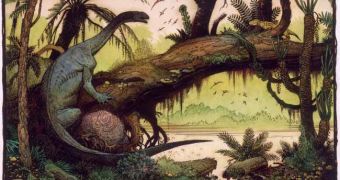Today, Antarctica is a frozen desert. But once, it was covered by a lush tropical vegetation and inhabited by heat-loving dinosaurs. A new research, published in the journal "Acta Palaeontologica Polonica", describes a large dinosaur that wandered across the Antarctica about 190 million years ago, during the early Jurassic period.
A partial foot, leg and ankle bones of the extinct beast were found by a team of Augustana College, during the early 90's, on Mt. Kirkpatrick near the Beardmore Glacier, in Antarctica, at an elevation of over 13,000 ft (4,000 m), but the remains have only recently been examined.
"The fossils were painstakingly removed from the ice and rock using jackhammers, rock saws and chisels under extremely difficult conditions over the course of two field seasons", said co-author Nathan Smith, a graduate student at The Field Museum, in Chicago.
The 20-25 ft (6-8 m) long and 4 to 6 tons heavy dino was called Glacialisaurus hammeri, it was a species of sauropodomorph, a dino branch including sauropods, the largest animals ever to walk the earth, like Diplodocus and Apatosaurus.
The new species shows that sauropodomorphs had a wide distribution in the Early Jurassic, inhabiting places from China to South Africa, South America, North America, and (now) Antarctica.
"This was probably due to the fact that major connections between the continents still existed at that time, and because climates were more equitable across latitudes than they are today", Smith said.
By Early Jurassic, the southern landmasses (Antarctica, South America, Africa and Australia) were forming a sole continent, Gondwana. They started to split off during the mid-Jurassic, about 167 million years ago.
The Glacialisaurus was discovered along with a possible sauropod, thus the earliest sauropods coexisted with the less evolved sauropodomorph relatives for a long period (it's like the Australopithecus would still be living with us).
"They are important because they help to establish that primitive sauropodomorph dinosaurs were more broadly distributed than previously thought, and that they coexisted with their cousins, the true sauropods", Smith said.
At the same site, researchers discovered a nearly complete skeleton of a theropod (meat eating) dinosaur, named Cryolophosaurus ellioti, pelvic bones from a possible sauropod, a pterosaur (dinosaur era flying reptiles) humerus bone, and the tooth of a large tritylodont (an extinct primitive type of mammal).

 14 DAY TRIAL //
14 DAY TRIAL //